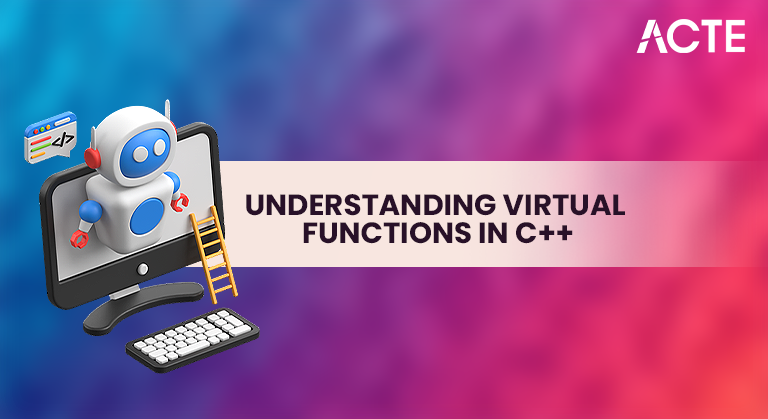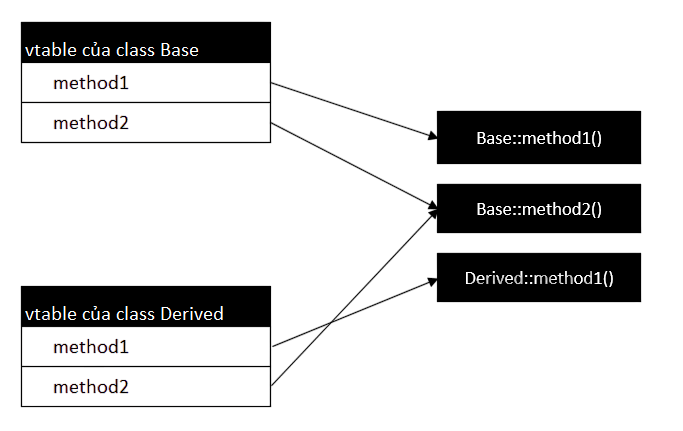
- Introduction to Polymorphism
- What is a Virtual Function?
- Syntax of Virtual Functions in C++
- Role of Virtual Functions in Runtime Polymorphism
- Base Class and Derived Class Behavior
- Function Overriding Using Virtual Functions
- V-Table and Virtual Table Mechanism
- Pure Virtual Functions and Abstract Classes
- Conclusion
Introduction to Polymorphism
In object-oriented programming, polymorphism allows objects to behave differently based on their data type or class hierarchy. C++ supports both compile-time (static) and runtime (dynamic) polymorphism. While function overloading and operator overloading enable compile-time polymorphism, virtual functions are the cornerstone of runtime polymorphism. Through virtual functions, C++ allows a function call to invoke different versions of a method depending on the type of the object, not the type of reference or pointer. This makes virtual functions essential for designing flexible and extensible software architectures.Polymorphism is a core concept in object-oriented programming (OOP) that allows objects of different classes to be treated as objects of a common superclass. The term “polymorphism” comes from Greek, meaning “many forms,” and it enables a single interface to represent different underlying data types or methods. This flexibility enhances code reusability, scalability, and maintainability Web Designing & Development Training . There are two main types of polymorphism: compile-time polymorphism (also known as method overloading) and runtime polymorphism (also known as method overriding). Compile-time polymorphism occurs when multiple methods have the same name but differ in the number or type of parameters. The method to execute is determined during compilation. Runtime polymorphism, on the other hand, is achieved through inheritance and allows a subclass to provide a specific implementation of a method that is already defined in its superclass. The decision about which method to call is made during program execution. Polymorphism is essential for implementing dynamic behavior in programs, enabling developers to write more generic and extensible code. By leveraging polymorphism, systems can handle new requirements with minimal changes, making it a foundational principle in modern software development.
To Earn Your Web Developer Certification, Gain Insights From Leading Data Science Experts And Advance Your Career With ACTE’s Web Developer Courses Today!
What is a Virtual Function?
A virtual function in C++ is a member function in a base class that you can override in a derived class. It is declared using the virtual keyword in the base class. When a base class pointer or reference is used to call a function that is overridden in a derived class, IPO Cycle the function from the derived class is invoked instead of the base class function. This mechanism enables runtime polymorphism, where function calls are resolved during execution, not compilation.

- class Base {
- public:
- virtual void display() {
- std::cout << "Base class display\n";
- }
- };
Here, display() is a virtual function, which means if a derived class overrides it, the overridden version will be called via a base class pointer.
Syntax of Virtual Functions in C++
The syntax for declaring a virtual function is straightforward. You prefix the function declaration in the base class with the keyword virtual.
- class Base {
- public:
- virtual void show();
- };
In the derived class, the function can be overridden without explicitly using the virtual keyword, Throw and Throws Java although doing so can improve readability. Virtual functions must be non-static and are typically declared public or protected so that they are accessible in the derived class context.
Would You Like to Know More About Web Developer? Sign Up For Our Web Developer Courses Now!
Role of Virtual Functions in Runtime Polymorphism
Virtual functions facilitate runtime polymorphism by enabling dynamic dispatch of function calls. When you use a base class pointer or reference to access overridden methods in a derived class Call a Function in Python, the function call is resolved at runtime based on the actual object type, not the pointer/reference type. This behavior is essential when dealing with inheritance and allows for designing extensible systems where new functionality can be added with minimal changes to the existing code.
Consider the example:
- Base* ptr;
- Derived obj;
- ptr = &obj;
- ptr->display();
This runtime resolution of function calls is what makes virtual functions powerful.
Base Class and Derived Class Behavior
When a base class declares a virtual function, any class derived from it can override that function. The overridden function in the derived class must have the same signature as in the base class Remove Duplicate Elements . If the base class pointer or reference points to an object of the derived class, the derived class’s implementation is executed.
- class Base {
- public:
- virtual void speak() {
- std::cout << "Speaking from Base\n";
- }
- };
- class Derived : public Base {
- public:
- void speak() override {
- std::cout << "Speaking from Derived\n";
- }
- };
Using override (a C++11 feature) is a good practice, as it provides compile-time checking that you are actually overriding a base class function.
Are You Interested in Learning More About Web Developer? Sign Up For Our Web Developer Courses Today!
Function Overriding Using Virtual Functions
Function overriding occurs when a derived class redefines a virtual function from its base class. Virtual functions enable the use of base class pointers to access overridden functions in derived classes. Without virtual functions, the base class version would always be called, regardless of the actual object type. Function overriding using virtual functions is a fundamental feature of object-oriented programming that enables runtime polymorphism. When a base class declares a function as virtual, it tells the compiler that the function can be overridden in any derived class Web Designing & Development Training. This means that if a derived class provides its own implementation of the virtual function, the version corresponding to the actual object type will be called at runtime, even if the object is accessed through a pointer or reference to the base class. This mechanism allows programs to decide which function to execute dynamically, based on the object’s actual type, rather than the type of the pointer or reference. Virtual functions are essential for designing flexible and extensible software, enabling behaviors like method overriding, where a derived class modifies or extends the behavior of its base class without altering its interface. Without virtual functions, the compiler would resolve function calls at compile time (static binding), which limits the ability to achieve polymorphic behavior. Overall, function overriding with virtual functions enhances code modularity and supports dynamic method dispatch, making it easier to implement complex systems that can adapt and evolve over time.
V-Table and Virtual Table Mechanism
Under the hood, C++ implements virtual functions using a structure known as the Virtual Table (V-Table). When a class has virtual functions, the compiler creates a table of function pointers (V-Table) for that class. Each object of that class contains a hidden pointer (called a vptr) to the V-Table. When a virtual function is called, Web Developer vs Software Developer the vptr is used to look up the function’s address in the V-Table and execute the correct version at runtime. This mechanism provides the dynamic dispatch needed for runtime polymorphism. The overhead introduced by this approach is minimal but necessary for supporting polymorphic behavior. The V-Table is generated at compile-time and used at runtime for function resolution.The V-Table, or Virtual Table, is a crucial mechanism used by many object-oriented programming languages, such as C++, to implement runtime polymorphism through virtual functions.

When a class declares one or more virtual functions, the compiler creates a V-Table a lookup table that holds pointers to the actual function implementations for that class. Each object of such a class contains a hidden pointer to its class’s V-Table. At runtime, when a virtual function is called through a base class pointer or reference, the program uses the object’s V-Table pointer to find and invoke the correct overridden function corresponding to the actual derived class. This dynamic dispatch ensures that the proper function is executed according to the object’s real type Backend Development , enabling function overriding and flexible behavior in inheritance hierarchies. The V-Table mechanism hides the complexity of dynamic method resolution from the programmer while providing efficient support for polymorphism. Without V-Tables, virtual function calls would require explicit checks or slower alternatives, reducing performance and flexibility.
Pure Virtual Functions and Abstract Classes
A pure virtual function is a virtual function that has no definition in the base class and is declared by assigning it to 0:
- class Shape {
- public:
- virtual void draw() = 0;
- };
Any class that contains at least one pure virtual function is called an abstract class and cannot be instantiated. Software Developer vs Software Engineer Derived classes must override all pure virtual functions to become concrete (i.e., instantiable). Abstract classes define interfaces or contracts that derived classes must fulfill. This concept is widely used in interface design, where a base class defines behavior without implementation, leaving it to derived classes to provide specific functionality.
Conclusion
The V-Table mechanism is a powerful and efficient way to implement runtime polymorphism in object-oriented programming. By maintaining a table of function pointers for classes with virtual functions, it enables dynamic dispatch, ensuring that the correct overridden method is called based on an object’s actual type. This allows developers to write flexible and extensible code, Web Designing & Development Training promoting reuse and modularity in complex software systems. Understanding how V-Tables work not only deepens your grasp of function overriding and virtual functions but also sheds light on the inner workings of many programming languages like C++. Mastering this concept is essential for building advanced applications that leverage the full power of polymorphism.





